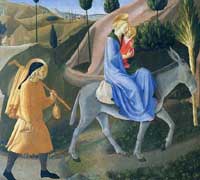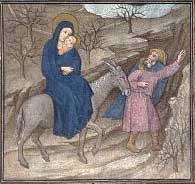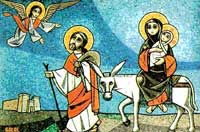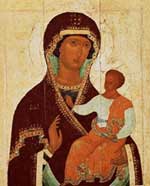|
“BLESSED BE EGYPT MY
PEOPLE.”
(ISAIAH 19:25)
On the 24th day of the Coptic month of Bashans, which
corresponds to the 1st of June, the Coptic Church celebrates the
entry of the Lord Jesus Christ into the land of Egypt. On that
day, the churches throughout the length and breadth of the land
that gave the Holy Family shelter resound with the words of the
Doxology:
“Rejoice, Oh Egypt; Oh, people of Egypt and all ye children of
Egypt who live within its borders, rejoice and lift up your
hearts, for the Lover of all mankind, He who has been before the
beginning of ages, has come to you”.
The Holy Family , in their escape from the infanticidal fury of
King Herod , chose their way to Egypt. They had to avoid the
beaten tracks altogether, and to pursue unknown paths, guided by
God and His Angel. They picked their way day after day, through
hides valleys and across uncharted plateaus in the (then) rugged
wastelands of Sinai, enduring the scorching heat of the sun by
day and the bitter cold of the desert nights, preserved from the
threat of wild beasts and savage tribesmen, their daily
sustenance miraculously provided, the all-too-human fears of the
young Mother for her infant allayed by the faith that infused
her with His birth.
And So they arrived, at last, safely, for God had pre-ordained
that Egypt should be the refuge for the one who has to bring the
message of peace and love to mankind.
The tortuous trails they followed in their passage across Sinai,
and their subsequent travels within Egypt, are chronicled by
Pope Theophilus, 23rd Patriarch of Alexandria (384-412 AD). He
testifies, in his celebrated annals, that on the eve of the 6th
of Hathor (the Coptic month corresponding roughly with
November), after long prayer, the Holy Virgin revealed herself
to him, and after relating the details of the Holy Family’s
journey to, in, and from Egypt, bade him record what he had seen
and heard. It is a source which no Christian believer would
question.
Besides, it is a virtual certainty that, at a time when happings
of a momentous or historical nature were transmitted by word of
mouth from one generation to the next, the account of Pope
Theophilus’s vision confirmed the oral tradition of supernatural
occurrences which accompanied the arrival of a wondrous Child in
the towns and villages of Egypt some 400 years earlier.
The route of the Holy
Family:
 According to the sources of the Coptic Church, the Holy Family
proceeded from Bethlehem To Gaza, and thence to El-Zaraniq (also
known as Floussiat), some 37 kms west of El-Arish; then they
threaded their way along northern Sinai until they reached Farma
(ancient Pelusium) mid-way between El-Arish and present-day Port
Said. It was their last stop in Sinai; and with the next leg of
their journey they put the perils of the wilderness behind them. According to the sources of the Coptic Church, the Holy Family
proceeded from Bethlehem To Gaza, and thence to El-Zaraniq (also
known as Floussiat), some 37 kms west of El-Arish; then they
threaded their way along northern Sinai until they reached Farma
(ancient Pelusium) mid-way between El-Arish and present-day Port
Said. It was their last stop in Sinai; and with the next leg of
their journey they put the perils of the wilderness behind them.
Tel Basta or Basta lies about 100 kms north-east of Cairo. Here,
Jesus caused a waterspring to well up from the ground, and His
presence caused the idols to c rumble, as foretold by the
prophets of old. The townsfolk, in consequence, turned
malevolent and aggressive, whereupon the Holy Family turned
their backs on the town and headed south.
In due course they reached Mostorod (which was called in those
day Al Mahamma) only about 10 km away from Cairo. Al Mahamma
means the Bathing Place, a name given to the town because the
Virgin Mary bathed the Christ Child and washed his clothes.
Eventually, on their way back to Palestine, the Holy Family
stopped once more at Mostorod and this time, caused a spring to
gush from the earth which still flows forth to the present day.
From Mostorod , The Holy Family took the way north-eastwards to
Belbeis (ancient PHilippos) at a distance of about 55 km from
Cairo. They rested there in the shade of a tree which was
therefore named as “The Virgin Mary’s Tree”.
Afterwards, the Holy Family took the north-west direction
reaching the small township of Meniet Samannoud ( known also as
Meniet Genah), they crossed the Nile to the city of Samannoud
(or Jemnoty) in the Delta, where the local population received
them with a kindness and hospitality that earned them deserved
blessing. There is in Samannoud , to this day, a large granite
trough which, according to local brief, was used by the Virgin
for kneading dough, and a water-well which the Christ Child
Himself hallowed.
Again towards the north-west, the Holy Family traveled until
they reached the city of Sakha in the lake district of Burullus.
The Coptic name of the town “Pekha-Issous” means “the foot of
Jesus” for the Holy Child’s foot-print was marked, here in bas
relief on a rock. The rock was preserved , but hidden for
centuries for fear of robbery and only unearthed again 13 years
ago.
After Sakha, the Holy Family crossed the Rosetta branch of the
Nile to the western Delta and heading south into Wadi el Natroun
(Natroun Valley) in the Western Desert of Egypt. In the earliest
decades of Christianity, the desert expanses of Wadi el Natroun
became the site of anchoretic settlement and , later , of many
monasteries, in spiritual commemoration of the Holy Family’s
passage through the Valley.
Eventually, they left the desert behind them and made their way
southwards, crossing the Nile to its eastern bank and heading
for Matariyah and Ain Shams (ancient Heliopolis, the site of the
oldest ‘university’ in history called since earliest Pharaonic
times ‘On’). Both these adjacent districts are outlying suburbs
of present-day Cairo, only round 10 km far from the city centre.
 At the time of the Holy Family’s arrival there, Ain Shams was
home to a large Jewish community, who had erected a temple – the
Synagogue of Unias, for their worship. In Matariyah, a tree
still stands to this day, still regularly visited, called
“Mary’s Tree”, for the Family is believed to have rested in its
shade. Here, too, the Infant Jesus caused water to flow from a
spring, from which He drank and blessed, and in which the Virgin
washed His clothes. She poured the washing water on the ground,
and from that spot, the fragnant balsam plant blossomed: besides
the healing and pain-soothing properties of this balm, its
essence is used in the preparation of the scents and perfumes of
which the Holy Chrism is composed. At the time of the Holy Family’s arrival there, Ain Shams was
home to a large Jewish community, who had erected a temple – the
Synagogue of Unias, for their worship. In Matariyah, a tree
still stands to this day, still regularly visited, called
“Mary’s Tree”, for the Family is believed to have rested in its
shade. Here, too, the Infant Jesus caused water to flow from a
spring, from which He drank and blessed, and in which the Virgin
washed His clothes. She poured the washing water on the ground,
and from that spot, the fragnant balsam plant blossomed: besides
the healing and pain-soothing properties of this balm, its
essence is used in the preparation of the scents and perfumes of
which the Holy Chrism is composed.
Setting out next towards Old Cairo, the Holy Family rested for a
while in Zeitoun, on their way , then proceeded along a course
which traverses which are now crowded bustling quarters of
Cairo, within which the serene landmarks of an earlier Coptic
heritage still stand, marking the paths of the Holy Family
followed.
* In central Cairo:
• The Church of the Virgin Mary in Zuweila Alley.
• The Church of St George the Martyr.
• The Church of St. Mercurios Abu Sefein (‘meaning he of the two
swords’)
• The Convent of the Virgin Mary.
• The Convent of St. George.
* In the down-town
district of Clot Bey:
• The Cathedral of St Mark in Azbakieh.
• Numerous Churches attached to the Cairo headquarters of many
Egypt’s monasteries
• The Church of the Virgin Mary (known by the name Ezbaweya)
The area now called Old Cairo, known as Misr El Kadima is among
the most important locations visited by the Holy Family where
the spiritual impact of their presence is most felt still,
though their stay was brief, for the Governor pf what was then
Fustat - enraged by the tumbling down of idols at Jesus’
approach – sought to kill the Child. But they took shelter from
his wrath in a cave above which, in later years, the Church of
Abu Serga (St Sergius) was built. This, and the whole area of
the fort of Babylon, is a destination of pilgrimage not only for
Egyptians but for Christians from around the world.
List of the sites which
are visited in the Fortress of Babylon:
• The Church of Abu Serga and the Crypt of the Holy Family
beneath it.
• The Hanging Church (Al Muallaqa) dedicated to the Virgin Mary
• The Church Of St Barbara
• The Church of St George
• The Church of the Virgin, identified by its alternative name
of Qasriet Al-Rihan (Basil Pot)
• The Convent of St George
• The Coptic Museum and the ramparts of the Fortress of Babylon.
• The Greek Orthodox Church of St George
• The Jewish Synagogue of Ben Ezra.
The Fustat section of Old
Cairo, which lies west of the Mosque of Amr Ibn’l As includes:
• The Church of St Mercurios Abu Sefein
• The Church of Abba Shenouda
• The Church of the Virgin Mary of Al-Demshiria
• The Convent of Abu Sefein
• The Church of the Virgin of Babylon El Darag
• The Church of Saints Abakir and Yohanna
• The Church of Prince Tadros Al Mishriqi
• The Church of the Archangel Mikhail (known also as Ala Malak
Al Qibli or ‘Southern Angel’)
• The Church of St Mena in Zahraa- Misr El Kadima
 After their short stay in Old Cairo, the Holy Family moved in a
southerly direction , reaching the modern Cairo suburb of Maadi
which, in earliest Pharaonic times, was an outlying district of
Memphis, the capital of Egypt then; and at Maadi, they boarded a
sailing-boat which carried them up the Nile towards southern
Egypt. The historic church built upon the spot from which they
embarked, also dedicated to the Virgin, is further identified by
the denominative ‘Al-Adaweya’, the Virgin’s Church ‘of the
Ferry’. After their short stay in Old Cairo, the Holy Family moved in a
southerly direction , reaching the modern Cairo suburb of Maadi
which, in earliest Pharaonic times, was an outlying district of
Memphis, the capital of Egypt then; and at Maadi, they boarded a
sailing-boat which carried them up the Nile towards southern
Egypt. The historic church built upon the spot from which they
embarked, also dedicated to the Virgin, is further identified by
the denominative ‘Al-Adaweya’, the Virgin’s Church ‘of the
Ferry’.
The stone steps leading down top the River’s bank and believed
to have been used by the Holy Family, are accessible to pilgrims
through the Church courtyard.
An event of miraculous import occurred on Friday the 3rd of the
Coptic month of Baramhat, the 12th of March 1976 A.D. A Holy
Bible of unknown provenance was carried by the lapping ripples
of the Nile to the bank below the Church. It was open to the
page of Isaiah 19:25 the page declaring “Blessed be Egypt My
People”. The Bible is now behind glass in the Sanctuary of the
Virgin in the Church for all to see.
The sail-boat docked at the village of Deir Al-Garnous (the
later site of the Monastery of Arganos) 10 km west of Ashnein el
Nassara (a small village near the town of Maghagha). Outside the
western wall of the Church of the Virgin there, a deep well is
believed to have provided the Holy Family with the water they
needed.
They went on from there to a spot later named Abai Issous, “the
Home of Jesus”, the site of present-day Sandafa village, east of
Al Bahnassa, the latter which stands some 17 km west of town of
Beni Mazar.
On towards the south they went from Bahnassa to Samalout and
crossed the Nile again from that town to the spot on the east
Bank of the River where the Monastery of the Virgin now stands
upon Gabal El-Tair (‘Bird Mountain’) or also called Gabal El Kaf
(‘Palm Mountain’) east of Samalout. Gabal El-Tair is known by
this name because thousands of birds gather there. The Holy
Family rested in the cave which is now located inside the
ancient church there. In this site it is said that the Holy
Family rested in the shade of the Mountain then Jesus stretched
His little Hand to hold back a rock which was about to detach
itself from the mountain-side and fall upon them. The imprint of
His palm is still visible.
When they resumed their travels, the Holy Family passed a laurel
tree a stone’s throw south of Gabal El Tair, along the pathway
flanking the Nile and leading from the Mountain to Nazlet Ebeid
and the new Minia Bridge of today. It is said that this tree
bowed for worship the Lord Christ as He was passing. The
configuration of the tree is indeed unique: all its branches
incline downwards , trailing on the ground, then turn upwards
again, covered in a cloak of green leaves. They call the tree Al
Abed “the Worshipper”.
 Once more crossing the Nile, back to its west bank, the Holy
Family traveled southwards to the town of Al-Ashmounein or
Hermopolis Magna but it seems that they didn't tarry long there.
Leaving behind them the rubble of fallen idols, they continued
still in a southerly direction, for another 20 Km or so to
Dairout Al-Sharif (which, like Al-Ashmounein, had an alternative
Greek name: Philes); and thence to Qussqam (or Qost-Qoussia).
Here, too, the recorded events testify that the townsfolk were
infuriated when the stone statue of their local deity cracked
and fell, and evicted the Holy Family from the town. A
historically recorded incident dating to that period refers to
the devastation of Qussqam, and Coptic tradition asserts that
the ruin that befell the town was the consequence of its violent
rejection of the gentle visitors. Once more crossing the Nile, back to its west bank, the Holy
Family traveled southwards to the town of Al-Ashmounein or
Hermopolis Magna but it seems that they didn't tarry long there.
Leaving behind them the rubble of fallen idols, they continued
still in a southerly direction, for another 20 Km or so to
Dairout Al-Sharif (which, like Al-Ashmounein, had an alternative
Greek name: Philes); and thence to Qussqam (or Qost-Qoussia).
Here, too, the recorded events testify that the townsfolk were
infuriated when the stone statue of their local deity cracked
and fell, and evicted the Holy Family from the town. A
historically recorded incident dating to that period refers to
the devastation of Qussqam, and Coptic tradition asserts that
the ruin that befell the town was the consequence of its violent
rejection of the gentle visitors.
We have an entirely different story in the warm welcome with
which the holy refugees were met at their next stop at Meir ( or
Meira ) only 7 Km west of Qoussia. Here, they found only
consideration and hospitality wherever they went, for which
treatment the town and its people were signally blessed.
Now it was time for the Holy Family to set out for what is,
arguably, the mast meaningful destination of all in the land of
Egypt, the place where there would be "an altar to the Lord in
the midst of the land of Egypt". Gabal (Mount) Qussqam, which
takes its name from the town nearby that was laid waste, is 327
kms south of Cairo, and stands in the Governorate of Assiut. The
Monastery of Al-Muharraq nestles against the western foothills
of the Mountain. It was built around the area where the Holy
Family remained just over six months. Their time was spent
mainly in a cave which became, in the Coptic era, the altar of
the Church of Virgin Mary, built at the western end of the
Monastery compound. The altar-stone was the resting place of the
Child Jesus during the months He dwelt there.
The whole area-the Monastery and its surroundings – is redolent
of the Coptic Christian ethos. So hallowed are its intimations,
that the Copts of Egypt named it the Second Bethlehem.
It was here, at the very spot where Al-Muharraq Monastery
stands, that the Angel of the Lord appeared to Joseph in a
dream, and said "Arise, and take the young Child and His Mother,
and go into the land of Israel; for they are dead which sought
the young Child's life" (Matthew 2:20 &21).
And so they set forth on the return journey. The route they took
deviated slightly from the one by which they had come. It took
them to Mount Dronka, 8 Km south-west of the city of Assiut, and
their blessing of this location was commemorated in the
Christian era by the building of the mountain-top Monastery of
Dronka.
Eventually, they arrived at Old Cairo, then Matariyah, and on to
Mahamma, retracing more or less their steps on their outward
journey across Sinai to Palestine.
Subsequent Biblical history says it all : at the end, they
arrived home, Joseph's old house, in the small town of Nazareth,
in Galilee, in the land of Palestine, from where the message of
Christ would, in the fullness of time, be heard.
The whole journey, from the initial flight from Bethlehem to the
return to Nazareth lasted over three years.
They had covered something like 2000Km their means of transport
a weak beast of burden and the occasional sail-boat on the Nile.
But for much of the way, the delicate Mother and the rugged old
Carpenter must have trudged on foot, enduring the fierce summer
heat and the biting winter's cold, suffering the pangs of hunger
and the parching affliction of thirst like hunted outlaws. It
was a journey of indescribable agony and anguish which the Child
Jesus, His Virgin Mother and the Sainted Joseph bore with inner
joy, and survived, for the sake of mankind.
Popular Christianity Places : |